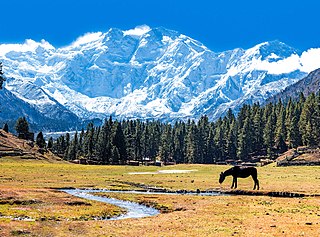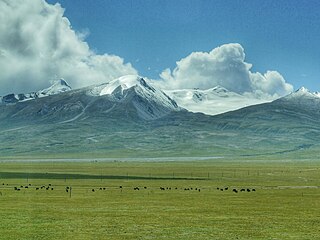Related Research Articles

Kangchenjunga, also spelled Kanchenjunga, Kanchanjanghā and Khangchendzonga, is the third-highest mountain in the world. Its summit lies at 8,586 m (28,169 ft) in a section of the Himalayas, the Kangchenjunga Himal, which is bounded in the west by the Tamur River, in the north by the Lhonak River and Jongsang La, and in the east by the Teesta River. It lies in the border region between Koshi Province of Nepal and Sikkim state of India, with the two peaks West and Kangbachen in Nepal's Taplejung District and the other three peaks Main, Central and South directly on the border.

The Himalayas, or Himalaya is a mountain range in Asia, separating the plains of the Indian subcontinent from the Tibetan Plateau. The range has several peaks exceeding an elevation of 8,000 m (26,000 ft) including Mount Everest, the highest mountain on Earth. The mountain range runs for 2,400 km (1,500 mi) as an arc from west-northwest to east-southeast at the northern end of the Indian subcontinent.

Mount Everest, known locally as Sagarmatha or Qomolangma, is Earth's highest mountain above sea level, located in the Mahalangur Himal sub-range of the Himalayas. The China–Nepal border runs across its summit point. Its elevation of 8,848.86 m was most recently established in 2020 by the Chinese and Nepali authorities.

The Karakoram is a mountain range in the Kashmir region spanning the border of Pakistan, China, and India, with the northwestern extremity of the range extending to Afghanistan and Tajikistan. Most of the Karakoram mountain range falls under the jurisdiction of Gilgit-Baltistan, which is controlled by Pakistan, within the larger disputed Kashmir region.

Makalu is the fifth-highest mountain on Earth, with a summit at an elevation of 8,485 metres (27,838 ft) AMSL. It is located in the Mahalangur Himalayas 19 km (12 mi) southeast of Mount Everest, on the China–Nepal border. One of the eight-thousanders, Makalu is an isolated peak shaped like a four-sided pyramid.

Cho Oyu is the sixth-highest mountain in the world at 8,188 metres (26,864 ft) above sea level. Cho Oyu means "Turquoise Goddess" in Tibetan. The mountain is the westernmost major peak of the Khumbu sub-section of the Mahalangur Himalaya 20 km west of Mount Everest. The mountain stands on the China–Nepal border, between the Tibet Autonomous Region and Koshi Province.

The eight-thousanders are the 14 mountains recognized by the International Mountaineering and Climbing Federation (UIAA) as being more than 8,000 metres (26,247 ft) in height above sea level, and sufficiently independent of neighbouring peaks. There is no precise definition of the criteria used to assess independence, and at times, the UIAA has considered whether the list should be expanded to 20 mountain peaks by including the major satellite peaks of eight-thousanders. All of the eight-thousanders are located in the Himalayan and Karakoram mountain ranges in Asia, and their summits lie in the altitude range known as the death zone.

Dhaulagiri, located in Nepal, is the seventh highest mountain in the world at 8,167 metres (26,795 ft) above sea level, and the highest mountain within the borders of a single country. It was first climbed on 13 May 1960 by a Swiss-Austrian-Nepali expedition. Annapurna I is 34 km (21 mi) east of Dhaulagiri. The Kali Gandaki River flows between the two in the Kaligandaki Gorge, said to be the world's deepest. The town of Pokhara is south of the Annapurnas, an important regional center and the gateway for climbers and trekkers visiting both ranges as well as a tourist destination in its own right.

Manaslu is the eighth-highest mountain in the world at 8,163 metres (26,781 ft) above sea level. It is in the Mansiri Himal, part of the Nepalese Himalayas, in west-central Nepal. Manaslu means "mountain of the spirit" and the word is derived from the Sanskrit word manasa, meaning "intellect" or "soul". Manaslu was first climbed on May 9, 1956, by Toshio Imanishi and Gyalzen Norbu, members of a Japanese expedition. It is said that, given the many unsuccessful attempts by the British to climb Everest before Nepali Tenzing Norgay and New Zealander Edmund Hillary, "just as the British consider Everest their mountain, Manaslu has always been a Japanese mountain".

Nanga Parbat, known locally as Diamer, is the ninth-highest mountain on Earth and its summit is at 8,126 m (26,660 ft) above sea level. Lying immediately southeast of the northernmost bend of the Indus River in the Gilgit-Baltistan region of Pakistan-administered Kashmir, Nanga Parbat is the westernmost major peak of the Himalayas, and thus in the traditional view of the Himalayas as bounded by the Indus and Yarlung Tsangpo/Brahmaputra rivers, it is the western anchor of the entire mountain range.

Gyachung Kang is a mountain in the Mahalangur Himal section of the Himalayas and is the highest peak between Cho Oyu and Mount Everest. It lies on the border between Nepal and China. As the 15th highest peak in the world, it is also the co highest peak that is not an eight-thousander; hence, it is far less well-known than the lowest of the eight-thousanders, which are only about 100 m (328 ft) higher. The peak's lack of significant prominence also contributes to its relative obscurity.

Nanda Devi is the second-highest mountain in India, after Kangchenjunga, and the highest located entirely within the country. Nanda Devi is the 23rd-highest peak in the world.

Annapurna II is the second-highest mountain of the Annapurna range located in Nepal, and the eastern anchor of the range.

The Lower Himalayan Range, also called the Lesser Himalayas or Himachal, is one of the four parallel sub-ranges of the Himalayas. It has the Great Himalayas to the north and the Sivalik Hills to the south. It extends from the Indus River in Pakistan to the Brahmaputra Valley in North East India traversing across North India, Nepal and Bhutan. The sub-range has an average elevation of 3,700–4,500 m (12,100–14,800 ft).

The Nyenchen Tanglha Mountains are a 700-kilometre (430 mi) long mountain range, and subrange of the Transhimalaya System, located in Tibet and the Tibet Autonomous Region of China.

Bandarpunch is a mountain massif in the Garhwal Himalaya in Uttarakhand, India. The massif has 3 peaks: White Peak, also called Banderpunch II, to the west above Yamunotri; almost 5 km east is Bandarpunch main peak or Banderpunch I ; and about 4 km to the north-east is Kalanag.

Mount Satopanth (7084m) is one of the prominent peaks of the Garhwal range in the Himalayas, located within the Indian subcontinent. It is also the second highest peak in Gangotri National Park.
References
- ↑ S. Sathyakumar; Mansi Mungee; Ranjana Pal (2020). "Biogeography of the Mountain Ranges of South Asia". Encyclopedia of the World's Biomes. Elsevier. pp. 543–554. ISBN 978-0-124-09548-9.
- ↑ "Physiography of Himalayas". Britannica . Retrieved 1 June 2024.
- ↑ Nag, Prithvish; Sengupta, Smita (1992). Geography of India. Concept Publishing. p. 40. ISBN 978-8-170-22384-9.
- ↑ "Great Himalayas". Britannica . Retrieved 10 November 2024.
- ↑ Potocki, Mariusz; Mayewski, Paul Andrew; Matthews, Tom; Perry, L. Baker; Schwikowski, Margit; Tait, Alexander M.; Korotkikh, Elena; Clifford, Heather; Kang, Shichang; Sherpa, Tenzing Chogyal; Singh, Praveen Kumar; Koch, Inka; Birkel, Sean (2022). "Mt. Everest's highest glacier is a sentinel for accelerating ice loss". Nature. 5 (1): 1–8. doi: 10.1038/s41612-022-00230-0 . Retrieved 1 June 2024.
- ↑ "Himalayas, Drainage". Britannica . Retrieved 1 June 2024.